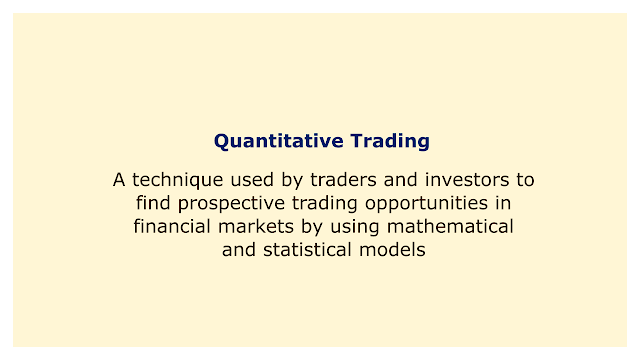 |
| Image: Moneybestpal.com |
Quantitative trading is a technique used by traders and investors to find prospective trading opportunities in financial markets by using mathematical and statistical models. In order to evaluate massive amounts of data and predict market movements and prices, it uses algorithms and computer programs.
To find lucrative trading opportunities, quantitative traders employ a variety of quantitative methods, including statistical models, machine learning algorithms, and econometric methodologies.
Quantitative trading aims to find patterns and trends in financial markets that can be profitably exploited by using the massive volumes of data that are currently available and cutting-edge analytical approaches. Hedge funds, investment banks, and other financial institutions with access to a wealth of data and cutting-edge technology frequently engage in this form of trading.
Simple statistical models to sophisticated machine learning algorithms that use deep learning and artificial intelligence to find trading opportunities are all examples of quantitative trading strategies. Stocks, bonds, currencies, and commodities are just a few examples of financial instruments that can be traded using these tactics.
Recent technological advancements and the accessibility of a wealth of data have increased the popularity of quantitative trading. It does, however, come with hazards and difficulties. The requirement for complex technology and data infrastructure, the possibility of model and data errors, the risk of market volatility, and the possibility of unforeseen occurrences that can interfere with trading plans are a few of the difficulties.
Quantitative trading aims to find patterns and trends in financial markets that can be profitably exploited by using the massive volumes of data that are currently available and cutting-edge analytical approaches. Hedge funds, investment banks, and other financial institutions with access to a wealth of data and cutting-edge technology frequently engage in this form of trading.
Simple statistical models to sophisticated machine learning algorithms that use deep learning and artificial intelligence to find trading opportunities are all examples of quantitative trading strategies. Stocks, bonds, currencies, and commodities are just a few examples of financial instruments that can be traded using these tactics.
Recent technological advancements and the accessibility of a wealth of data have increased the popularity of quantitative trading. It does, however, come with hazards and difficulties. The requirement for complex technology and data infrastructure, the possibility of model and data errors, the risk of market volatility, and the possibility of unforeseen occurrences that can interfere with trading plans are a few of the difficulties.
